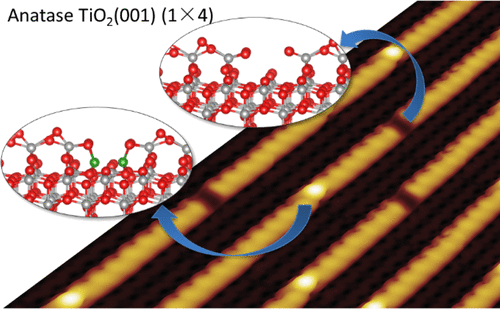当前位置:
X-MOL 学术
›
J. Phys. Chem. C
›
论文详情
Our official English website, www.x-mol.net, welcomes your
feedback! (Note: you will need to create a separate account there.)
Structure and Reactivity of Anatase TiO2(001)-(1 × 4) Surface
The Journal of Physical Chemistry C ( IF 3.3 ) Pub Date : 2018-06-21 , DOI: 10.1021/acs.jpcc.8b02777 Huijuan Sun 1 , Wencai Lu 1 , Jin Zhao 2
The Journal of Physical Chemistry C ( IF 3.3 ) Pub Date : 2018-06-21 , DOI: 10.1021/acs.jpcc.8b02777 Huijuan Sun 1 , Wencai Lu 1 , Jin Zhao 2
Affiliation

|
TiO2 anatase (001) surface which usually exhibits (1 × 4) surface reconstruction has attracted lots of research interests for its potentially high photocatalytic activity. The atomic structure of the reconstruction and defects of this surface play an important role on its reactivity. Besides the well-known add-molecule model reconstruction, the add-oxygen model (AOM) for anatase (001)-(1 × 4)-reconstructed surface by adding one oxygen atom to each Ti4C atom was proposed. In this work, we investigate the geometric and electronic structures as well as the H2O and O2 adsorption behavior on anatase (001) surface with AOM systematically. The different defect structures including oxygen vacancy (OV), Ti interstitial (Tiini), and TiO2 vacancy (TiO2)V are also studied. Our calculations show that oxidization makes the AOM surface inert to molecular adsorption. The TiO2 vacancy with Ti interstitial, (TiO2)V–Tiini, is found to be the only reactive site for water and oxygen molecules adsorbing on the TiO2 anatase (001)-(1 × 4)-reconstructed surface. The investigations based on AOM can explain the atomic-resolved scanning tunneling microscopy results appropriately. Our systematic study of the AOM reconstruction of anatase (001) provides new insights into the understanding of the structure and reactivity on this surface.
中文翻译:

锐钛矿型TiO 2(001)-(1×4)表面的结构和反应性
通常具有(1×4)表面重构的TiO 2锐钛矿(001)表面因其潜在的高光催化活性而吸引了许多研究兴趣。重建的原子结构和该表面的缺陷对其反应性起重要作用。除了公知的加成分子模型重构外,还提出了通过向每个Ti 4C原子中添加一个氧原子来构成锐钛矿(001)-(1×4)重构表面的加成氧模型(AOM)。在这项工作中,我们系统地研究了AOM在锐钛矿(001)表面上的几何和电子结构以及H 2 O和O 2的吸附行为。不同的缺陷结构,包括氧空位(O V),Ti间隙(Ti ini)和TiO 2空位(TiO 2)V也进行了研究。我们的计算表明,氧化使AOM表面对分子吸附呈惰性。发现具有Ti间隙(TiO 2)V –Ti ini的TiO 2空位是水和氧分子吸附在TiO 2上的唯一反应位点锐钛矿(001)-(1×4)重建的表面。基于AOM的研究可以适当地解释原子分辨扫描隧道显微镜的结果。我们对锐钛矿(001)的AOM重构的系统研究为了解该表面的结构和反应性提供了新的见识。
更新日期:2018-06-22
中文翻译:

锐钛矿型TiO 2(001)-(1×4)表面的结构和反应性
通常具有(1×4)表面重构的TiO 2锐钛矿(001)表面因其潜在的高光催化活性而吸引了许多研究兴趣。重建的原子结构和该表面的缺陷对其反应性起重要作用。除了公知的加成分子模型重构外,还提出了通过向每个Ti 4C原子中添加一个氧原子来构成锐钛矿(001)-(1×4)重构表面的加成氧模型(AOM)。在这项工作中,我们系统地研究了AOM在锐钛矿(001)表面上的几何和电子结构以及H 2 O和O 2的吸附行为。不同的缺陷结构,包括氧空位(O V),Ti间隙(Ti ini)和TiO 2空位(TiO 2)V也进行了研究。我们的计算表明,氧化使AOM表面对分子吸附呈惰性。发现具有Ti间隙(TiO 2)V –Ti ini的TiO 2空位是水和氧分子吸附在TiO 2上的唯一反应位点锐钛矿(001)-(1×4)重建的表面。基于AOM的研究可以适当地解释原子分辨扫描隧道显微镜的结果。我们对锐钛矿(001)的AOM重构的系统研究为了解该表面的结构和反应性提供了新的见识。


















































 京公网安备 11010802027423号
京公网安备 11010802027423号